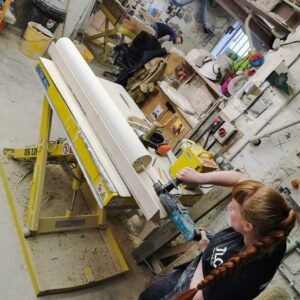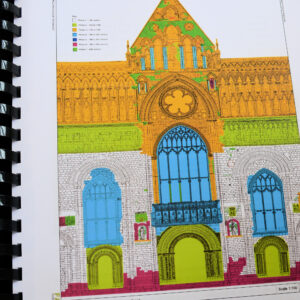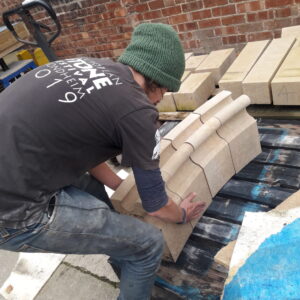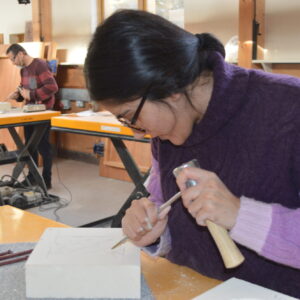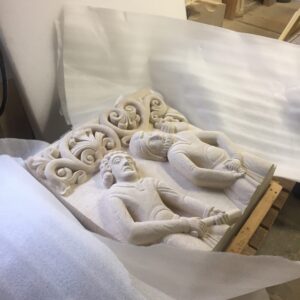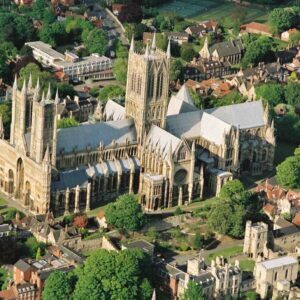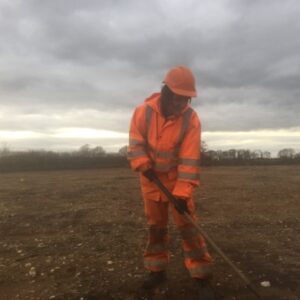Religious building
Lincoln Cathedral
The Cathedral was founded by Bishop Remigius and was constructed between 1072-1092 in the Norman style.
Much rebuilding and restoration has taken place over the Cathedral’s 900+ life, a fire taking place in 1141 followed by an earthquake in 1185 led to rebuilding works. From the medieval period through to the Victorian period the Cathedral continued to be added to and altered. In recent times the cathedral has undertaken several restoration and maintenance projects.
Skills used at Lincoln Cathedral
Stone Masonry
Lincoln Cathedral is mostly built from Lincolnshire Limestone and was quarried locally before the late 18th century stone was not normally carried more than 10 – 20 miles from the quarry site. Even today the Lincolnshire Limestone used on the repair and restoration of the Cathedral is quarried locally to ensure that the stone is matched in quality and colour to the same weather conditions.
One thing that has not changed since its conception is that the cathedral will always need stonemasons. Throughout history stonemasons have been responsible for building our Cathedrals and churches amongst other famed buildings and structures across the world.
Stonemasonry is the creation of buildings, structures, and sculpture using stone as the primary material.
Various types of Stone Masons:
- Quarrymen
are responsible for splitting sheets of stone and extract the resulting stone from the ground. - Sawyers
take rough chunks of stone and refine them to meet the required shapes.
- Banker masons
are workshop-based, their specialism is working stone into shapes required by a building’s design which is set out on templates, referred to as 'face moulds' 'bed moulds' or 'sections'. They can produce anything from stones with simple chamfers to tracery windows. When working a stone from a sawn block, the mason ensures that the stone is bedded in the right way, so that the finished work sits in the building in the same orientation as it was formed on the ground or an orientation befitting the load to be placed upon it depending on the structure it is forming.
- Carvers
use their artistic ability to carve stone into foliage, figures, animals or abstract designs. Carvings can represent religious scenes, real people or be a design of the carvers choosing. Sketches are made and models can be produced to ensure the carving is in keeping with the style of the building. - Fixer masons
specialise in the fixing of stones onto buildings or rebuilding failed structural elements. They use lifting equipment such as lewis pins, block and tackle or hoists and fix the stones in place using traditional lime mortars with the occasional addition of hot lead pouring in to specially cut holes to help lock the stones together. - Memorial masons
carve gravestones and inscriptions and need to be skilled at the art of letter cutting and the setting out by hand of complex text.
At a place like Lincoln Cathedral masons tend to be multi skilled; for example a banker mason can also be a fixer mason, or a fixer mason can also be a good carver. Everyone has their own specialization, but masons need to have a good understanding of all aspects of the job. As well as traditional masonry, when working on such an old building, masons also need to know conservation methods such a variety of stone cleaning techniques, repointing and mortar repairs.
Conservation
Conservation is the process of maintaining and managing change to a heritage asset in a way that sustains and where appropriate enhances its significance.
The conservation team at Lincoln Cathedral work mostly with stone, but also can work on anything fabric-related such as the mosaics, plaster, or monuments. Additionally, they occasionally work on conserving wooden items. The department’s main aim is to work towards preserving items, or working to keep original items on the building.
The team are a bit different to the other departments, as they have to begin their process by creating reports of the current conditions of buildings, documenting everything in precise detail to ensure that their work maintains the characteristics of the old building. In their reports, they create a timeline of a specific sculpture’s inception, to the condition of the sculpture in the current period. They also must include detailed historical analysis of the significance of a sculpture in the wider national and international context, and the significance it has physically on the building itself. This is then followed by the scientific surveys - the report must show any geological importance of the materials the building is made from, and the paintwork (polychromy) condition report can be interpreted to advise on ongoing work.
The report is created to determine why and how quickly the site is deteriorating, and what to do to repair it. The conservators need to strongly justify every action about why items can or can’t be kept on the building.
For the majority of the carvings, the conservation process is as follows: set up site and make sure all equipment is prepared, record everything (by photograph and writing), ascend the scaffolding with the head mason and assess what can be saved and what needs to be replaced, clean sculpture with machine or fine-tuned laser, fill out basic reports, carry out repairs to remove old stone/iron, take final photos and move onto the next site.
The dirt from the industry etc sticks to the limestone, cement is a particular problem which needs to be removed as it often does a lot more damage.
The west front of Lincoln Cathedral is famous for its 12th century carved frieze which runs right across the facade from the northern corner of the west front around the southern corner, to the southern side of the building. The frieze consists of a series of panels, each a little more than one metre high and varying in width, on which scenes have been carved showing scenes from Heaven and Hell and conveying messages from both the Old and the New Testament. This is one of the most important romanesque friezes in Europe, and the Cathedral secured Heritage Lottery funding to conserve it, and have almost completed their work.
Glazing and leadwork
The glaziers have a large studio in the works department at Lincoln cathedral, complete with their own kiln, dark room, light boxes, specialist sinks and recording equipment. Unlike many of the other departments at the cathedral, the glazing department tends to work quite separately to the rest of the team - they do sometimes undertake small jobs on the other listed properties in the area, but for the most part they’re heavily conservation-based in their studio.
At normal capacity, the glass working department consists of 4 glaziers, but this has been reduced due to Covid. At the centre of one of their workrooms is a custom large table, designed to hold the weight of full long lancet windows they may be working on.
Glass work is very scientific, involving different chemicals and metals in order to create reconstructions of stained glass, or in order to sympathetically repair it to be replaced in the cathedral.
In addition to workshop activities, the glaziers are also often out and about in the Cathedral itself to record any ongoing movement of the window brackets or any small cracks in order to anticipate future repair work.
Joinery
There are currently 7 joiners in the workshop at Lincoln cathedral, and they work on a variety of jobs between the Cathedral itself, and 83 other listed (bar one) buildings in Lincoln. Due to the variety of buildings they regularly work on, they have to be accomplished at a plethora of joinery skills.
Often the joiners will undertake structural repairs, repairs to timber beams or supports, roof repairs and occasionally they’re involved in full house renovations which includes fitting brand new kitchens and bathrooms to bring them up to renting standard.

The joiners liaise with the other teams within the works department at the cathedral, as their work is necessary to facilitate the other teams (for example, the joiners at Lincoln Cathedral make the frames which go around conserved or restored stained glass, and so they work closely with the glazers to ensure the glass is fit properly). They also work closely with the stone masons doing centring for the stone masons' projects.
The joiners at the cathedral work with other materials too such as lead, which is needed to create watertight seals in roofing.
Workers come from a level 2 or 3 NVQ background, not specifically heritage, but they become specialised in working on listed/historically important buildings.


